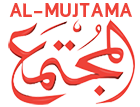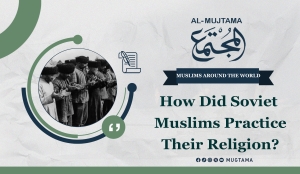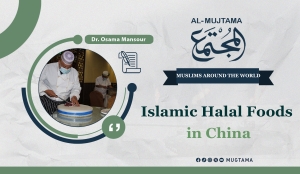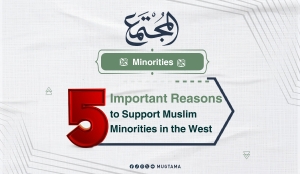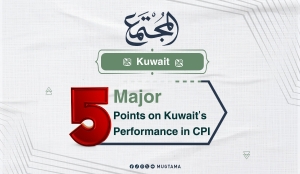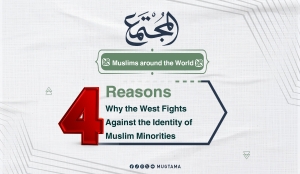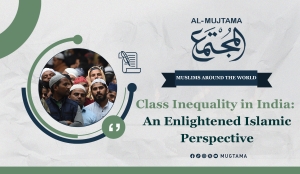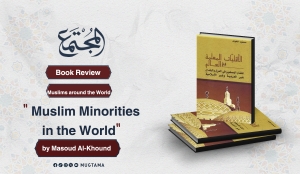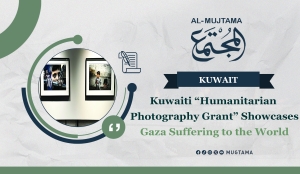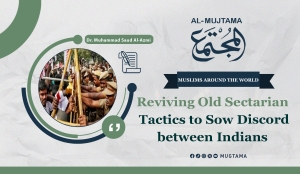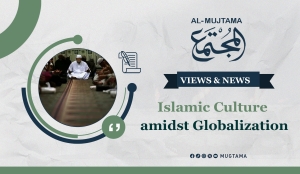Admin Mugtama
How Did Soviet Muslims Practice Their Religion?
March 05, 2025
Violence and Defiance by the USSR
The Union of Soviet Socialist Republics (USSR) dealt with Islam in these republics with violence and defiance since it extended its influence over those lands. The police seized all copies of the Quran and burned them between 1929 and 1936. They were assisted in this by several atheist associations that conducted anti-Islam propaganda at the time.
Anti-Religious Campaigns in the Media
The Soviet government used all media to achieve its goal of fighting Islam and its followers. For example, in 1962, 23,000 lectures were delivered in the Republic of Uzbekistan against religion. Cinemas and radio stations were used to fight religion and distort the image of Muslims who went to mosques, fasted during Ramadan, or celebrated Islamic holidays.
Union of Atheists and Prevention of Pilgrimage
To this end, the communists established the Union of Atheists in 1923 and prevented pilgrims from going to the Kaaba. Before the Soviets took over Islamic lands, the number of Muslim pilgrims in these areas was about 35,000 annually. However, with these fierce campaigns targeting Islam for years, their number under Soviet rule ranged between 15 and 20 pilgrims only in some years! In many years, no Soviet pilgrims reached the Kaaba!
Practicing Religion Amid Fear
Under these extremely difficult circumstances, Muslims practiced their religion amid waves of intense fear. Therefore, during this period, only the elderly appeared as mosque-goers due to the prohibition of prayer, fasting, and pilgrimage on the pretext that it economically affected Soviet society. Faced with this, some religious leaders in Russia issued fatwas that aligned with Soviet goals, allowing Muslims to perform their religious rituals in a way that did not affect the economy's future.
Fatwas to Align with Soviet Goals
For example, these fatwas permitted Muslims to pray only once a day and to fast for only one day during the entire month of Ramadan! The Soviet authorities issued an order prohibiting the slaughter of sacrificial animals, even if they were privately owned, on the pretext of the economic damage that would result from slaughtering such a large number of sacrificial animals.
Sources for Further Reading
For further information on this topic, you can refer to the following sources:
- Michele Companjen's “Muslim Minorities and Modernity: Hints from Europe,” Chapter on Muslims in the Soviet Union.
- Mikhail Ryklin's “Communism as Religion,” which covers aspects of Soviet anti-religion campaigns, including against Islam.
- Dmitry V. Shlapentokh's “Russia Between East and West: Scholarly Debates on Eurasianism,” discussing religious policies in the Soviet Union.
- Silvio Ferrari and Sabrina Pastorelli's "Religion in Public Spaces: A European Perspective," specifically on how the USSR dealt with religious practices.
Islamic Halal Foods in China
March 05, 2025
Chinese cuisine is one of the most important cultural and historical pillars in China. It is an important cultural heritage for the Chinese nation. Since Muslims in China are an integral part of the Chinese nation, Islamic food forms a significant part of the Chinese cultural heritage.
Islamic foods have been formed based on the complete adherence to Islamic Sharia law, and they have developed by adopting the best culinary practices from various ethnic groups. Therefore, they are not only distinguished by Islamic food characteristics but also possess the impressive features of Chinese food, with their colors, aromas, flavors, and beautiful shapes.
History of the Development of Islamic Foods
The history of Islamic foods in China dates back to the Tang and Song Dynasties (618 - 1271 AD). During this time, the customs of the Arabs and Persians residing in China, including their food and drink customs, were transferred to China. Descriptions of Arab and Muslim foods have been found in several Chinese literary works of that time, such as the writer Liu Xun in his book "Lingbiao Luyi," where he described the Arabian dates, and Fang Qianli in his article in the book "Jami’ al-Adwiya," where he described the Arabian sweets and fish, etc.
Some Chinese writers also described Muslim food, such as Zhou Yue in his book "Talks in Pingzhou," where he said: "Muslims are similar to the Chinese in their food, but they do not eat pork, nor do they eat the meat of animals that are not slaughtered."
During the Yuan Dynasty (1271 - 1368 AD), Islamic foods were included in the imperial court’s food list, indicating the ruling class's interest in Islamic food. Among the most famous of these foods were lamb meat and baked cakes.
During the Ming and Qing Dynasties (1368 - 1911 AD), not only did the variety of Islamic foods increase, but they also gained wide fame. For example, the "whole lamb" dish was praised by the poet Yuan Mei during the Qing Dynasty when he said: "Preparing it requires skill akin to taming a dragon, and it includes 72 types of foods, all cooked with lamb meat."
Islamic Foods Today
Islamic foods have retained their unique flavors and ingredients over the centuries. Their fame was not the only reason for their survival until today. The reason lies in their inheritance among famous Muslim chefs generation after generation.
In modern times, dozens of types of Islamic food menus have been composed and published, including: "Islamic Food in China," "The Food of the Hui People," "The Whole Lamb Banquet," "The Light Meals of the Hui People," and "The Indexed Islamic Food Table." These books were composed by famous Muslim chefs in various parts of China and serve as an important window into the traditional foods of Chinese Muslims.
Features of Islamic Foods
The features of Islamic foods are as follows:
- Adherence to Islamic Sharia Law: Chinese Muslims might be lax in some aspects of Islamic law like praying and fasting, but they consider halal food a red line that cannot be crossed. They do not merely refrain from eating pork, but even mentioning the word "pig" in front of them is considered a great insult. They are also keen on consuming lamb, beef, and even chicken slaughtered according to Islamic law, in slaughterhouses supervised by well-known righteous and pious Muslim imams.
- Use of Fragrant Spices: Islamic foods rely on fragrant spices and are accustomed to cooking food well, unlike some Chinese foods that are half-cooked.
- Beautiful Colors and Good Smell: Islamic foods are characterized by their beautiful colors, good smell, delicious taste, and high cleanliness. Some of them are even used as remedies for several diseases. For example, it is mentioned in the "Encyclopedia of Food and Drink" by Hu Si Hui during the Ming Dynasty (1368 - 1644 AD) that some foods made from beef and lamb meat, like lamb dough and beef breast, are medicinal foods that have proven their effectiveness. Moreover, a type of yeast made from soybeans by Muslims, when mixed with flour, is effective in removing facial pimples.
- Affordable Prices: Despite their quality and delicious taste, Islamic foods are also characterized by their affordable prices. Thus, Muslim restaurants are in great demand even by non-Muslims, who prefer Islamic food over other foods.
Regions and Dishes
Muslim gathering areas in Chinese provinces are distinguished by their unique dishes that have distinctive flavors suitable for the products of these regions. Among the most famous of these dishes are:
- Beef Noodles (Niu Rou La Mian): This is the most famous Islamic food in China, but it originates from Gansu Province in northwestern China. It consists of noodles made fresh from flour and water, boiled for a few moments, then placed in dishes with vegetables and beef, topped with hot meat soup, and served to customers. Because it is delicious and affordable, it is widespread in all Muslim areas in China.
- Hand-Eaten Lamb in Ningxia (Shou Zhua Yang Rou): Ningxia Hui Autonomous Region is famous for raising sheep and has various types of good-quality sheep. The most famous Islamic dish in Ningxia is hand-eaten lamb, which consists of boneless lamb ribs served fresh and eaten by Muslims with their hands after dipping it in black vinegar. It is a permanent dish in most Ningxia restaurants.
- Big Chicken Dish (Da Ban Ji): This is the official dish in the Xinjiang region where Uyghurs live. It is similar to Arab foods due to the region's proximity to Central Asia. It consists of pieces of chicken meat with vegetables and Chinese spices and is widespread in most Muslim gathering areas in China.
5 Important Reasons to Support Muslim Minorities in the West
March 04, 2025
Our noble religion always urges us to become an integrated nation, interconnected by harmony and cooperation in facing life and its challenges, as well as the plots of enemies towards this religion. Hence, every single verse and hadith that stipulates or gives example for such meanings, also includes the mutual effort to support Muslim minorities particularly in Western lands where they stand against grave challenges threatening them instantaneously, darkening their very existence. The following are some reasons that compel us to come to the aid of our brothers from Muslim minorities in Western countries:
- The Bond of Brotherhood in Faith:
These are the strongest bonds of faith among the children of the Islamic Ummah. Looking thus, we must shift the perception of minorities from being a marginal secondary issue to one of factors that should be of primary concern to Muslim countries and peoples.
- Following the Example Set by the Prophet:
The model of the Muslim state during the time of the Prophet Muhammad (may peace be upon him) gave much attention to Muslim minorities during periods of peace and war. Examples of this include the Prophet sending ambassadors like Musab ibn Umair to Medina, Muadh ibn Jabal, Abu Musa al-Ash'ari, and Khalid ibn al-Walid to Yemen, among other companions to various regions.
- A Necessity to Improve the Image of Islam in the West:
Muslims in Western countries could be a model for advocates of goodness and reform, holding forth a shining representation of Islam, making them an example of Muslims who take pride in their faith. However, for this to happen, they need needful care and support.
- Building a Bridge of Communication between the Islamic Maternal World and the Western World:
Muslim minorities today are living at the focal intersection where conflict has developed among both Islamic and Western sides; thus, it is they who are the most qualified and able to comprehend both parties and represent the relationship lost between them.
- The Preservation of the Identity of the Muslim Ummah:
Without a shadow of a doubt, the communities of Muslim minorities in Europe represent an important part of the identity of this Ummah. Thus, guarding such communities against Westernization, disintegration, and enforced integration will hold for them as a safeguarding measure for the major core of the identity of the Islamic Ummah. Freedom of thought and work for minority communities shall give them the privilege to maintain their traditional settings and cultural identity, which is very essential to preserve the identity of an important part of the Islamic world.
5 Major Points on Kuwait's Performance in CPI
March 04, 2025
Kuwait maintained a score of 46 in the 2024 Global Corruption Dharna Index (CPI), but dropped two positions globally, internationally 65th, 7th in Arab countries, and final in the Gulf region. Here are the main points about Kuwait's performance in the index:
- Stable score despite the ranking drop
Although Kuwait did not improve its overall score, it maintained stability at 46, reflecting the balance between improvement in some sources and a decline in others.
- Improve some evaluation sources
Kuwait saw a significant improvement in 4 evaluation sources with a total of 18 points, while 4 other sources declined by 17 points, contributing to the balance in total.
- Countries' risks in risk classification
In the country's risk classification index released by The Economist Intelligence Unit, Kuwait's rankings greatly improved 14 points, which increased by 37 to 51, which Kuwait has recorded this year.
- Encouraged signs to increase national integrity
In the year 2024, there were many positive developments in the fight against corruption, including:
- Repetition of political leadership, Rajkumar Sheikh Mishal al-Ahmed through His Majesty's high speech, to combat corruption and protect public money.
- To adopt accountability and improvement decisions in public administration for those involved in the forgery of Kuwaiti nationality.
- To activate the role of a financial intelligence unit after issuing a royal decree appointing a new head.
- To issue judicial decisions against ministers and leaders in the public sector related to corruption and misuse of electricity cases.
- Ranking in Kuwait's Gulf and globally
In the Gulf: Kuwait was ranked at the last place, while the UAE topped the list, followed by Qatar, Saudi Arabia, Oman and finally Bahrain.
International level: Kuwait fell to 65th position, underlining the need for continuous efforts to increase integrity and combat corruption.
Despite maintaining the same score in the corruption index, some areas indicate the existence of improvement, improvement efforts that, according to al-maskas, require further work to increase transparency and accountability and achieve tangible progress in the coming years.
A closer examination of the clash of civilizations reveals that the most important and prominent element in this struggle always revolves around identity. Identity represents the true and main component of any group, category, state, or civilization; without identity, distinction ceases to exist, and the essential being disappears.
The Significance of Identity
Therefore, the issue of identity is one of the most significant problems facing Muslim minorities in the West in general. Identity has been the foremost crisis for early Muslims in non-Muslim societies, and now we can say that the issue of identity has become more sensitive and complex than ever, especially after the increase in the number of converts to Islam in the West and the rise of the phenomenon of "Islamophobia." This situation has made identity the primary reference through which individuals of Muslim minorities outside the Islamic world are judged.
Rising Hostility and Its Causes
With the rising hostility towards Muslim minorities in the West in recent years, researchers and specialists in minority affairs have found that this stems from fundamental and significant reasons, including the following:
- Safeguarding Religion and Protection Against Assimilation
Preserving the identity of members of Muslim minorities is, in itself, a safeguard for the religion of Islam within these minorities and a protection against assimilation and melting away.
- Cohesion and Resilience Against Destructive Integration
The adherence of Muslim minorities to their identity, in both its Islamic and civilizational aspects, makes them more capable of cohesion and resilience in the face of destructive integration campaigns and false globalization, as well as attempts to impose a Western identity on everyone.
- Protection Against Westernization and False Integration
Preserving the Islamic identity of minorities protects them from intended Westernization and false integration, thus allowing the retention of the identity of the Muslim nation that is intended for obliteration. Clearly, the more these minorities can create a space for themselves that ensures freedom of worship and belief, the more they can preserve their heritage and civilizational, social, and cultural identity.
- Positive Participation and Civilizational Interaction
Positive participation and civilizational interaction stem from individuals' own feelings about their identity and the degree of pride they have in it. The more minorities cling to what their identity dictates, the more steadfast and stable they become. This has always reflected positively on the environment in which a person or group exists. Conversely, as the identity of these groups weakens, their members tend to withdraw from the field of civilizational interaction, which results in their inability to effectively influence the surrounding communities.
Class Inequality in India: A Deep-Rooted Issue
Class inequality in India comes from thousands of years ago. It is a deeply embedded and multifaceted social phenomenon that touches all facets of life. This inequality is reflected in the traditional caste system, which segregates Indian society into hierarchical social classes with prescribed rights and duties.
Historical Deep Roots and Religious and Societal Background
The caste system is thousands of years old, dividing society into four main categories, or castes: Brahmins (priests), Kshatriyas (warriors), Vaishyas (merchants), and Shudras (laborers). People are born into a caste — and remain there for life — which is a barrier to social and economic mobility. You've got the so-called "untouchables," or "Dalits," who live outside the caste system and experience extreme discrimination.
British colonialism acted to reinforce class inequality, á la the caste system, to divide and control society. The British treated the lower levels of society as less than humans and refused to give them any access to education or jobs.
Economic and Social Inequality
India has seen significant economic development recently, but a great deal of inequality exists when it comes to the distribution of wealth. While the upper classes in control retain the vast majority of wealth, the lower classes suffer from extreme poverty as a result of this system and live on the streets in places where they are denied access to basic services.
Long-Standing Customs and Traditions
Long-standing customs and traditions support class inequality, where beliefs in the caste system are taught through generations. Discrimination and prejudice indicate that lower classes have little or no place in society.
The Disastrous Results of Class Inequality
1- Extreme Poverty: The lowest classes do not even have food, clean water, shelter, or a doctor, which increases health and social problems.
2- Discrimination and Persecution: Members of lower castes face discrimination, especially Dalits, in education, employment, and housing. They are subjected to violence and lack basic rights.
3- Differences in Education and Jobs: The upper classes enjoy better opportunities, and lower classes are limited in advancement opportunities.
4-Social Tensions: Frustration and anger among lower classes lead to protest and social unrest.
Islam's View about Class Inequality
According to the book “Encyclopedia of the Beauties of Islam” and Response to the Doubts of the Insane,” Islam provides such fundamental principles that can eradicate the class inequality in India:
- Social Justice: Islam promotes social justice and equality among people.
- Almsgiving and the Alleviation of Poverty: Almsgiving (Zakat) is one of the five pillars of Islam, so this book emphasizes the charitable component as a means to reduce income gaps and alleviate poverty.
- Islamic Rejection of Discrimination: Islam within Quranic verses and other hadiths rejects racial and class discrimination within inline chapters, promoting equality and justice between individuals.
- Consequence Islamic: Sharing of wealth with the poor and needy, helping.
- Fighting Class Inequality: These Islamic approaches can instigate a fight against class inequality in India through:
- Enacting and enforcing laws to combat discrimination and ensure equal opportunities for education and employment.
- Economic Empowerment — Giving lower classes jobs, aiding small businesses, and increasing access to financial services.
- Advocacy: Supporting policies and movements that work to bridge the gap between different economic classes. Delivering quality education for everyone
- Mindset Shift: Embedding a culture of respect and tolerance that counters the ideals that underpin the caste.
Ultimately, combating class inequality in India demands collaborative action from the government, civil society, and individuals alike. Applying Islamic principles and values is the way forward for India to attain a just and equal society.
Overview and Purpose
The book “Muslim Minorities in the World" by Masoud Al-Khound is a distinguished work that stands out in its unique topic of research and discussion. The book is considered a solid reference for any researcher on the affairs of Muslim minorities in countries worldwide. It is also an easy reference for any Muslim who feels for the plight of Muslims everywhere. The book's smooth style allows readers to absorb its knowledge without boredom or fatigue.
Comprehensive Study of Muslim Minorities
The book contains a study of the conditions of minorities and accurately monitors most information about them. It includes Muslim minorities of different races, backgrounds, customs, and cultures worldwide. The author divides the book into several chapters, making it easy for readers to access the minority they wish to read about and learn about their conditions. The book contains abundant information about each minority, making it a valuable encyclopedia in this field.
Chapter Structure and Content
The book is divided into 5 chapters, covering Muslim minorities worldwide according to the continents they are located in and the countries they reside in. It also discusses their nature, origins, and conditions, among other aspects of interest to the reader. Notably, the book does not leave out any Muslim minority, whether small, medium, or large, without mentioning and detailing them.
The five chapters of the book are as follows:
Chapter One: Titled “Muslims in Africa,” this chapter discusses the conditions and situations of Muslim minorities and the spread of Islam in regions such as Sub-Saharan Africa, Far West Africa, the Gulf of Guinea, Central Africa, East Africa, Northeast Africa, the Nile Valley, Southern Equatorial Africa, Southern Africa, and the Indian Ocean Africa.
Chapter Two: Titled “Muslims in Asia,” this chapter discusses the conditions and situations of Muslim minorities and the spread of Islam in regions such as India and its peripheries, Northeast Asia, the Indochinese Peninsula, Southeast Asia, and Oceania in the South Pacific.
Chapter Three: Titled “Muslims in America,” this chapter discusses the conditions and situations of Muslim minorities and the spread of Islam in regions such as North America, Latin America, and South America.
Chapter Four: Titled “Muslims in Europe,” this chapter discusses the conditions and situations of Muslim minorities and the spread of Islam in regions such as Germanic Europe, Benelux, Northern Europe, the British Isles, Latin Europe, Central Europe, the Balkans, and Eastern Mediterranean Europe.
Chapter Five: Titled “Muslims in the Former Soviet Space,” this chapter discusses the conditions and situations of Muslim minorities and the spread of Islam in regions such as the Baltic States, Eastern Europe, the Caucasus, and the Islamic Central Asian Republics.
In conclusion, “Muslim Minorities in the World” by Masoud Al-Khound is an invaluable and comprehensive resource on the conditions and experiences of Muslim minorities globally.
Through meticulous research and a thoughtful approach, the book offers a wealth of information that caters to both scholars and everyday readers. Its methodical organization, detailed insights, and engaging writing style make it an essential reference for anyone seeking to understand the diverse and multifaceted realities of Muslim communities across continents. This work stands as a testament to the importance of documenting and sharing the stories of these communities, fostering greater awareness and empathy in an increasingly interconnected world.
When words fail to convey the truth, the lens speaks with an undeniable voice, and a picture becomes worth more than a thousand words. In a world filled with events and conflicts, stories of suffering often fade behind news headlines, but some insist that these stories should be visible and felt, in a language understood by all: the language of images.
From this point, "The Humanitarian Photography Grant" was born as an innovative project that allows photographers in war-torn areas to be witnesses of history and guardians of the people's memory. The first version of the grant launched from the heart of Gaza, where pain and resilience embrace, and from the rubble emerged ten Palestinian lenses to convey untold stories and images pulsating with truth, witnessing one of the most severe humanitarian tragedies of the modern era.
Global Stations: From Gaza to Washington and Sharjah
The grant did not stop at supporting photographers only; it carried their message to the world through a series of exhibitions that began in Washington and then moved to Sharjah, where the images resonated widely within cultural and humanitarian circles. These exhibitions served as a genuine window through which Gaza shows itself to the world, with the cameras of its children, not through the lenses of outsiders.
In this context, Sami Al-Rumayan, the head of the grant, stated: "In Gaza, photography is not just an art; it is an act of resistance against obscuration. We have worked to empower photographers there to be a truthful mirror of what is happening and to let their voices reach the world through works that convey deep suffering and the glow of resilience."
He added, "We believe that the image carries a powerful message capable of making a wide impact. Therefore, through this grant, we aim to empower photographers to convey the voices of those who have none, and to enhance the culture of visual documentation of human tragedies."
Untold Stories of Gaza
The Humanitarian Photography Grant opened its first photographic exhibition in the United States titled "Through Their Lens: The Untold Stories of Gaza," which embodies the painful humanitarian reality experienced by Gaza through works by a select group of Palestinian photographers who have used their lenses to convey the truth and document the details of suffering and resilience in one of the most violent genocides in modern times.
The exhibition included powerful documentary photographs taken by local photographers in Gaza, where each image tells a separate story, bearing the suffering of families, the resilience of children, the sacrifices of women, and the dreams of youth that do not wither despite the destruction. These images reveal the human face of war, which often hides behind political headlines.
Sharjah Hosts "Lenses Pulsing with Humanity"
The grant's participation in the "Exposure 2025" festival in Sharjah marked the culmination of its journey, as the exhibition served as a genuine window through which Gaza shows itself to the world through the lenses of its children, not through the lenses of outsiders. The displayed photos were not just photographic shots; they were speaking humanitarian documents, narrating details of life and death and telling stories of hope amid pain.
For his part, Saad Al-Otaibi, Chairman of the Board of Trustees of the award, said: "This exhibition is not just a collection of photographs; it is a living testimony and the heartbeat of a land that challenges death daily. We are not only providing photographers with a professional opportunity, but we are also giving them a global voice that transcends the boundaries of silence."
He indicated that "the goal is to give photographers in Gaza a real chance to be the creators of their own narrative, to convey the scene through the eyes of those who have lived it, rather than through the eyes of distant observers."
He also pointed out that the Board of Trustees will work to ensure a supportive environment for the photographers participating in the grant and other grants while ensuring that their work is directed toward issues of deeper impact, encouraging them to produce impactful visual content that contributes to positive change.
Al-Otaibi concluded his remarks by saying, "We hope that this grant will serve as a turning point in the journey of humanitarian photography and contribute to highlighting inspiring human stories that reflect the resilience of individuals and communities in the face of challenges."
Empowerment Through Art: The Role of Humanitarian Partnerships
This grant came through the empowerment of humanitarian organizations that believe in the necessity of supporting photographers under harsh conditions, including Namaa Charity, the "Islamic Charitable Organization" in Kuwait, and "Kaf Humanitarian" in Bahrain.
In this context, Al-Otaibi emphasized the importance of cooperation with supporting entities.
Humanitarian Photography: A Visual Testimony to History
The photographers who participated in this grant were not just professionals seeking beautiful shots; they were witnesses to pain and hope, narrators of stories that words cannot convey.
Hussein Al-Moussawi, Editor-in-Chief of National Geographic Arabic, spoke about the importance of this exhibition: "What this exhibition presents goes beyond the boundaries of art, becoming a documentation of living human history. We do not view these images merely as creative works but as visual documents carrying messages for future generations, shedding light on details that may be forgotten but remain etched in the memory of the lens and humanity."
In Conclusion: A Journey Not Yet Over
This exhibition is the first in a series of exhibitions around the world, where the humanitarian photography grant will continue to convey the voice of Gaza, telling the world the story of a land that bleeds resilience and a sky that rains cries of hope. As Al-Rumyan confirmed, "Our journey has begun, and our message continues. These are not just pictures; they are a call for humanity to awaken."
In the age of social media, information spreads rapidly across the internet, making it easy for anyone to publish claims or threats that can escalate social and political tensions. Recently, India has witnessed numerous cases where individuals used threats via email and social media to spread hatred and chaos.
An Old Tactic in a New Style
It is evident that an old tactic is being reused but in a different style. Previously, there were attempts to create chaos in communities through incidents such as throwing corpses or meat in front of Hindu temples to tarnish the reputation of Muslims. However, with the development of social media and the spread of news online, this tactic has become easier and faster to reach as many people as possible. Through email or posts on Twitter or Facebook, false threats or fabricated information can be spread to sow discord and incite fear.
These threats, which may initially seem unserious or false, lead to catastrophic results in the long run. The rapid spread of fake news instills fear and hatred among individuals, contributing to increased sectarian divisions in society. By portraying Muslims as the main perpetrators of these events, any efforts for peaceful coexistence between religions are undermined.
Online Threats: Notable Examples
Threat to Kumbh Festival
In December, an online threat targeted the Hindu Kumbh festival. The threat came from an account named "Nasser Pathan" and included messages threatening to bomb the festival and kill thousands of participants. After police investigation, it was discovered that the account was fake, and the person responsible for the messages was a 17-year-old student named Aayush Kumar Jaiswal.
Investigations revealed that the young man used a fake Muslim name to send the threats as a "joke," attempting to implicate Muslims and tarnish their reputation. This incident raised widespread questions about how technology is used to create sectarian divisions in society.
The Second Case: Threat to Ram Temple
On December 27, 2023, Devendra Tiwari, a resident of Lucknow, received a threatening email from an alleged account named "Zubair Khan." The email included threats to bomb the Ram Temple and kill prominent government officials, including Uttar Pradesh Chief Minister Yogi Adityanath.
However, after thorough investigations, it was found that the email was sent by two Hindu individuals who used fake Islamic names to send the threats with the aim of spreading hatred and reinforcing negative stereotypes about Muslims.
Analyses indicated that this type of threat is nothing but a political game aimed at increasing hatred towards Muslims by portraying them as a threat to the country's internal security. It was also found that the individuals were actually trying to misuse their false affiliation to create hostility between communities. This raises questions about how rumors and lies spread in the age of social media and how anyone can exploit online platforms to spread hatred.
Political Tactics and Identity Manipulation
These incidents are not new. Often, the Muslim community in India faces deliberate manipulation to tarnish its image in the media and society. The most common tactic is to spread false threats attributed to individuals belonging to Islamic religions, aiming to reinforce negative stereotypes about Muslims in society. However, with the development of social media, this method has become more powerful and widespread.
Professor Apoorvanand from Delhi University points out that these tricks have been used in the past on several occasions to tarnish the reputation of Muslims. Blaming "others" in hostile situations and false threats can lead to increased sectarian strife. These tactics do not merely target individuals but seek to impart a religious character to daily incidents, creating an environment filled with suspicion and distrust between communities.
Impact on Communities
It is clear that these incidents directly affect the Muslim community, as they are held responsible for actions they did not commit. Additionally, these false threats contribute to reinforcing sectarian divisions, leading to more violence and conflicts between individuals and communities. By falsely exploiting religious identity, a state of polarization and tension is created that is difficult to overcome.
These incidents also contribute to the growth of Islamophobia, where Muslims are viewed as "enemies" or "threats" to national security. These tricks are used to spread fear and reinforce divisions among different groups in society, making it difficult to build mutual trust between sects.
The Political Aspect of Threats
There is a strong political aspect associated with these online threats. Although some individuals may carry out these attacks for personal reasons or due to affiliation with certain groups, the larger goal is to create a state of political polarization and benefit from sectarian divisions. For example, Devendra Tiwari, who was involved in several similar cases, aimed to gain political benefits by fueling sectarian tensions and using them as a tool to achieve his goals.
It has become clear that these threats do not only originate from ordinary individuals but also from political figures seeking to benefit from these strifes to increase their popularity or achieve electoral gains. With the repetition of these incidents, the question remains: Is there a political intention to increase sectarian hostility in society?
The Role of Media
The media plays an important role in shaping public opinion and conveying news objectively, but it can sometimes be a party to reinforcing negative stereotypes. In cases like these, some media outlets tend to portray Muslims as the source of every threat, contributing to the growth of Islamophobia in society.
The spread of misleading videos or false information through platforms like X (formerly Twitter) makes it difficult to distinguish between truth and deception. In many cases, these means are exploited to divert attention from the real culprits and pressure a certain group in society to tarnish its reputation.
Conclusion
Sectarian threats online are among the most dangerous challenges facing modern societies. They not only destroy the lives of targeted individuals but also threaten the social and human fabric of communities. There must be greater awareness among everyone, whether individuals or institutions, to limit the spread of these negative patterns and confront them decisively. At the same time, the efforts of governments and civil society must come together to combat Islamophobia and reduce the negative impacts of these incidents, ensuring a more tolerant and coexistent society.
Islamic Culture amidst Globalization
February 28, 2025
Impact of Globalization on Islamic Youth
Globalization has largely succeeded in achieving intellectual domination over generations of Muslims since the mid-20th century, starting with World War I and solidified in World War II, alongside the Western colonization of Muslim countries and the movement of Orientalism. It was further reinforced with the development of global cinema and the dominance of American cinema in world art, presenting a one-sided cultural vision in the absence of an Islamic identity, especially after the fall of the Ottoman Caliphate and the fragmentation of Muslims into closed-border states after having been a significant power.
Cultural Globalization and Its Mechanisms
Sheikh Yusuf al-Qaradawi articulates the dangers of globalization on Muslim cultural identity by stating: "The most dangerous form of globalization, with the farthest-reaching effects, is the globalization of culture, meaning the imposition of one nation's culture upon all other nations, or the culture of the dominant and powerful nation over the weaker and submissive nations.
In other words, it is the imposition of American culture on the entire world, be it Eastern or Western, Muslim or Christian, monotheistic or committed, pagan or libertine. The means to achieve this goal are the powerful tools and mechanisms that transcend continents and oceans — from media outlets and the influence of readable and audible words, to visual sound and images, live broadcasting, the information network, and others.
Cultural globalization seeks to skin us of our identity, to strip us of our skin, or to remove our identity, compelling us to spend in our nation its intellectual products and cultural goods that are filled with radiation and bear death and destruction."
Globalization's Influence on Fashion and Thought
For example, to illustrate the dominance of Western culture among Arab youth, it is sufficient to take a look at the types of clothing worn by young people of both genders and how Western fashion attracts most of them, evaluating individuals based on how much they embrace or reject it. The same applies to atheistic thought, capitalism, and the culture of mingling, women's work, feminism, marriage, and family building. The phenomenon of atheism has even become a new intellectual trend, with individuals choosing to be atheists simply to be labeled as cultured.
Westernization of the Arabic Language
As for the Arabic language and the attempts to westernize it in Arab countries, the situation is dire. One can barely find commercial shops using the Arabic language, and we see young girls mastering English vocabulary better than they know the Quran, making English their preferred mode of communication and a symbol of their progress or backwardness.
Devastating Effects on Religion, Education, and Morals
In this context, we find that globalization has devastating effects on religion, education, and morals that cannot be quantified. Efforts must be combined to confront it to steer the nation back onto the right path.
Distinctiveness of Islamic Universality vs. Western Globalization
Some may confuse the universality of Islam as a divine heavenly project that God Almighty has chosen for humanity, sending the final prophet, Muhammad (peace be upon him), as guidance for all worlds, with globalization as a project of earthly dominance that entices people toward all that is base, serving Satan and those who benefit from it.
Islamic Guiding Project
An impartial researcher can clearly distinguish between the universality of Islam and the Western globalization of the world, even if he is not a Muslim. The launch of the Islamic project from the dawn of history was based on the saying of the Companion Rabi' bin Amer to Rustam, the Persian leader: "We are a people whom God has sent to bring out whomever He wills from the worship of servants to the worship of the Lord of servants."
Call to Action
Islam is a guiding project from the Lord of the worlds, revealed by God to His Messenger to bring happiness to humanity in both realms. It does not seek gain for those behind it, nor does it request compensation from people.
Distinguishing Universal Islamic Call
The universal nature of Islam was not determined by the Messenger (peace be upon him) himself but is an inherent aspect of the religion as outlined by God Almighty in His Book. As it is stated: "It is nothing but a reminder for the worlds" (Sad: 87), and, "And We have not sent you except as a mercy for the worlds" (Al-Anbiya: 17). Additionally, "Indeed, the first house established for mankind is the one in Bakkah, blessed and a guidance for the worlds" (Al-Imran: 96), and, "Blessed is He who sent down the Criterion upon His Servant that he may be to the worlds a warner" (Al-Furqan: 1), and, "And We have not sent you except to all mankind as a bringer of good tidings and a warner" (Saba: 28).
The universality of Islam extends to the universality of the Prophet of Islam and his nation after him, as long as they carry the global project to guide humanity and show mercy towards them. It is thus a divine commission rather than just an honor for a nation; it is a constructive project, not a destructive one; a project of construction, not demolition; it advocates values and principles rather than gains and spoils.
On the other hand, globalization, which began with the idea of economic control and dominance to strip nations of their resources and subjugate them for the benefit of a group driven by European racism, is essentially a destructive project aimed at damaging minds, economies, and identities and attempting to detach individuals from all that empowers them and protects their roots.
Confronting Globalization with Islamic Culture
It is well known that flowing water drives away stagnant water if it stands in its path, and the project of globalization is stagnant, foul water, even if it appears otherwise to the observer. Its apparent strength through its wide-ranging means is merely a reflection of the weakness of those responsible for the divine Islamic project and their failure to renew their methods, contenting themselves with confinement and defending the idea in words rather than actions.
Educational Institutions and Intellectual Engagement
We must establish educational institutions and expand the specializations that assist in this field under the supervision of Arab and Islamic states; if this is not feasible, it should be under the supervision of major Islamic institutions, such as Al-Azhar for example, and the concerned and widely spread Islamic associations in our countries, as well as the International Union of Muslim Scholars, to devise a flexible educational plan to engage the minds of the youth and confront thought with thought.
Directed Artistic Production
Those responsible for the arts in general and businessmen in particular should focus on directed artistic production. The importance of art lies in the ease of conveying information and educational value in an accessible and appealing manner.
Media Development
We must develop media and guide distinguished minds to meet the nation’s needs in this critical area, ensuring the discourse matches the events and the tasks at hand.
Empowering Youth and Confronting Consumption Culture
Directing the nation’s energy and wealth towards production and employing youth to fill their intellectual and physical voids is essential. It is also important to prepare girls for a mission greater than just securing a job for financial and familial independence and to confront the culture of consumption that has transformed our countries into vast consumer markets for Western products.
Finally, these are broad guidelines to confront a serious issue that worries the scholars of the nation, but the weak resources in their hands remain a significant obstacle in facing this major dilemma, and the gap remains vast between us and our ability to confront it.
